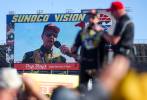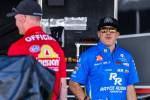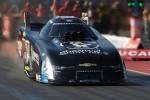Misunderstood racer Bobby Isaac never received due recognition
It's funny how it takes a lifetime, perhaps two, for some people to finally get their due.
How it took an extra 30 years for a skinny, soft-spoken and illiterate kid from a 12-acre cotton farm in rural Catawba County, N.C., a lifetime to get national recognition for a sport he so greatly helped change is a tale that more than deserves a little ink.
Death took a humble and misunderstood Bobby Isaac too early from this world, but Dodge would bring him back.
Dig up those advertisements from 10 years ago that were splashed across newspapers from Rockingham to Raleigh, N.C., and you'll see the most overlooked racing champion this world has ever known.
Isaac is right there in orange and black, piloting his Number 71 around the track.
"Dodge is back!" the advertisements bragged.
But so was Bobby.
Not that anyone could really remember.
In the history of motorsports in North America, Isaac is the enigma wrapped in a race car. He didn't search the spotlight. The spotlight found him.
He's the cliché hard-luck story with the unfortunate ending. His amazing rise from farm boy to mill worker to racing champion is the stuff of Hollywood. Only Hollywood was never really interested. And, truth be told, neither was Isaac.
Born in 1932 (or 1934, since accounts vary) in the heart of dirt-track country in the foothills of North Carolina's Blue Ridge mountains, Isaac was one of nine children who at age 6 had to cope with the death of his father. Tragedy struck just 10 years later when his mother died.
And things rarely got better from there.
In what would be a pattern that would haunt his short life, Isaac bounced around from job to job and town to town. He worked on the back of ice trucks, in sawmills, was married at 19 and divorced at 20.
Somewhere in there, racing became an option only because it was easier and paid better than cutting lumber.
After seeing his first race at age 17, Isaac got the itch. He bought a 1937 Ford with whatever money he could scrape together and put roll bars in it.
"I thought it was a race car," Isaac recalled years later. But it wasn't. In his first race, Isaac flipped the Ford on the second lap.
He continued to race and within a few years left the pool-hall jobs and the cotton mills to race five nights a week for a local North Carolina man named Frank Hefner. Within five years, Isaac found himself in the driver's seat of his first Grand National car, the predecessor to the National Association for Stock Car Auto Racing Winston Cup Series, now known as Sprint Cup. Isaac began 15th at a race in Charlotte, N.C., and went two whole laps in a Holly Farms-sponsored car before it broke down. For that he earned 50 bucks.
But Isaac wanted more.
After a year spent on small-town dirt tracks, Isaac received a call from a wealthy man named Bondy Long who had purchased a Plymouth from ace driver Richard Petty and wanted Isaac to run the car for the 1963 season. Running inferior equipment, Isaac led only 30 laps that season, but he was already drawing attention from other owners.
Isaac won a Daytona (Florida) qualifying race in 1964, but it would be four years before he saw another checkered flag. When he did return to Victory Lane, things would never be the same.
During the 1967 season, Isaac ran 12 races in a Dodge for Nord Krauskopf's K&K Insurance team, then went full-time in 1968, winning three races, finishing second to David Pearson in the points standings (despite 13 fewer wins that year) and seeing more money ($60,000) than he had seen in the previous four seasons combined.
Two years later, he won the whole thing, taking 11 of 54 races and 32 top-five finishes.
But somehow the magic was gone.
After that championship in 1970, Isaac would never be the same. Over the next six seasons he would never run another full schedule and often complained that the grind of the season was too much for him. Things got strange in a hurry.
On Aug. 12, 1973, Isaac pulled his car into the pits while in the lead during the Talladega 500 in Atlanta, Ga., and retired on the spot.
"I quit driving," Isaac told Pearson that day.
"What do you mean?" Pearson asked.
"I told them to get somebody else to drive."
Legendary driver Buddy Baker later remembers Isaac saying "voices told him to get out of the car."
Isaac would drive again, however, 11 times in 1974, six times in '75 and twice in 1976. But he was done winning and his money disappeared as fast as it came in. He ran his final professional race on May 30, 1976, finishing 38th in Charlotte. On Aug. 14 of the following year, Isaac pulled out of a race in Hickory, N.C., with 25 laps remaining, climbed out of the car and collapsed on the hood of a nearby truck after suffering a massive heart attack.
He died in the hospital hours later.
The skinny, shy and often-misunderstood kid from North Carolina with the letters L-O-V-E tattooed on his knuckles was gone.
Isaac would be inducted into motor sports halls of fame all over the country, but he would never really get the accolades he deserved.
And then on the eve of Dodge's return to NASCAR racing in 2001, a picture appeared in nearly every major newspaper.
That orange car was winning again.
Steven Reive is a feature writer with Wheelbase Media. He can be reached on the Web at www.wheelbase.ws/media by using the contact link. Wheelbase supplies automotive news and features to newspapers across North America.
















